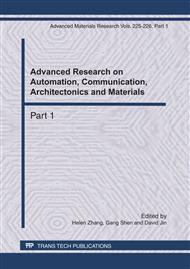p.234
p.239
p.243
p.247
p.251
p.255
p.259
p.263
p.268
The Research of the Odorous Pollutants Dispersion Forecasting and Simulating Model
Abstract:
Odorous pollution increasingly becomes a serious environmental and social problem. Due to its complexity and a wide range of sources, affected by meteorological, topography, hypsography etc surroundings, being not easy to master its pollution diffusion regularity, odor has been a major hot and difficult problem in the departments of environmental protection administration. According to its characteristics of various composition, odorous pollutants having short time in diffusion way, the higher instantaneous concentrations, the odorous pollutants forecast models are established on the basis of gauss diffusion model, In the paper, we establish odorous pollutants dispersion prediction stimulation models on the basis of gauss diffusion model, including point source diffusion model, enclosed point source diffusion model. it provides technical support odorous pollutants forecasting and simulating.
Info:
Periodical:
Pages:
251-254
Citation:
Online since:
April 2011
Authors:
Price:
Сopyright:
© 2011 Trans Tech Publications Ltd. All Rights Reserved
Share:
Citation:


